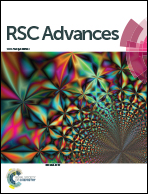Tuning conductivity and magnetism of CuFe2O4via cation redistribution†
Abstract
Copper ferrite polycrystalline samples with different cation distributions are prepared via different thermal treatments. Combined studies including X-ray diffraction, PPMS, Mössbauer spectroscopy, and complex impedance spectroscopy show both conductivity and magnetism keep increasing, accompanied by an obvious phase transition from tetragonal symmetry (I41/amd) to cubic symmetry (Fd![[3 with combining macron]](https://www.rsc.org/images/entities/char_0033_0304.gif) m) as Cu2+ ions migrate from Oh sites to Td sites. The changes of structural, electrical and magnetic properties due to the cation redistribution are also investigated by spin-polarized density functional theory. The simulated results indicate that the semiconducting band structure gradually transforms into a metallic band structure as Cu2+ ions migrate from Oh sites to Td sites. The conductivity and magnetism will increase during the same process, which matches well with the experimental observations. This work demonstrates that the cation redistribution in copper ferrite is effective in controlling both conductivity and magnetism, which can be further exploited in applications using interacting electron/spin systems.
m) as Cu2+ ions migrate from Oh sites to Td sites. The changes of structural, electrical and magnetic properties due to the cation redistribution are also investigated by spin-polarized density functional theory. The simulated results indicate that the semiconducting band structure gradually transforms into a metallic band structure as Cu2+ ions migrate from Oh sites to Td sites. The conductivity and magnetism will increase during the same process, which matches well with the experimental observations. This work demonstrates that the cation redistribution in copper ferrite is effective in controlling both conductivity and magnetism, which can be further exploited in applications using interacting electron/spin systems.



 Please wait while we load your content...
Please wait while we load your content...